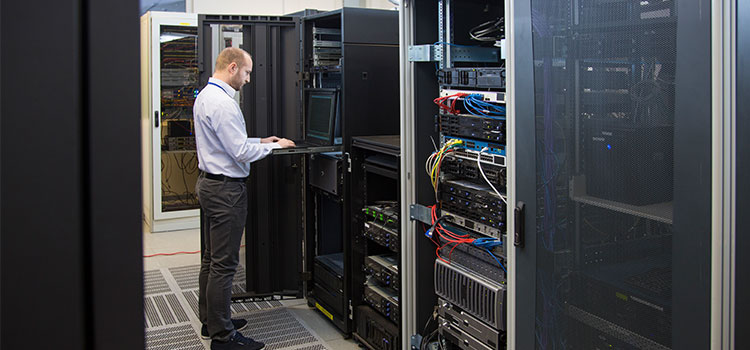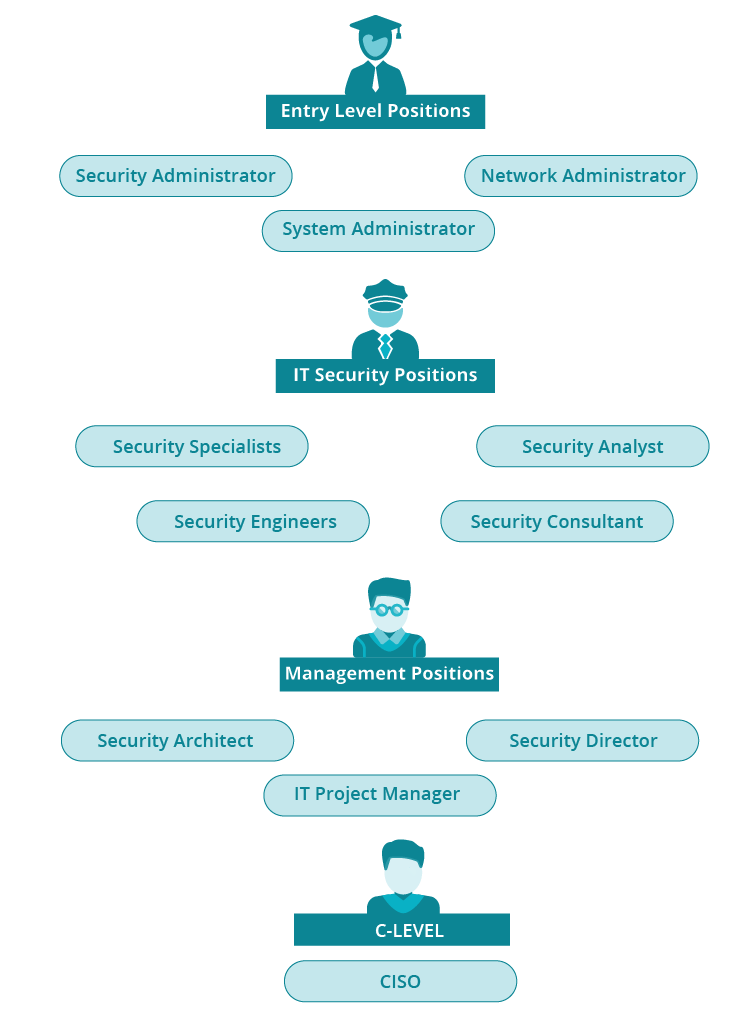CYBER SECURITY ARCHITECT: EDUCATION, DUTIES & SALARY

A security architect plays a vital role in the IT department, responsible for designing systems, managing employees, and evolving the organization's security needs. This article explains the roles and responsibilities of security architects, their job requirements, salary estimates, and possible career paths.
WHAT IS A SECURITY ARCHITECT & WHAT DO THEY DO?

A cyber security architect designs security systems to thwart malware, hacker intrusions, and Denial of Service (DDOS) attacks. They test for any vulnerabilities and audit the entire system.
Cyber security architects may work with other managers to implement employee protocols to maintain system integrity. They also need to instruct staff on new standards and procedures, stay abreast of current trends in the security field, and upgrade the system when necessary.
Managing Employee Protocols and Procedures
As an information security architect, one of your primary responsibilities is to work with other managers to implement employee protocols that maintain system integrity. These protocols are especially crucial in high-level security situations, such as when handling data vital to national security. In such cases, you may need to implement extreme policies, such as physical screenings upon entering and exiting the department or not leaving workstations unattended.
Instructing Staff on New Standards and SECURITY Trends
You will also be responsible for instructing your staff on new standards and procedures when they are rolled out. As a management-level employee, you will need to stay up-to-date with current trends in the security field. This includes attending conferences and reading industry publications to learn about new security software and best practices for designing a security architecture.
Upgrading the System When Necessary
When you are knowledgeable about the latest trends in the industry, you will be better equipped to assess when and how to upgrade your system. You will need to oversee the rollout of new software packages, ensuring the integrity of the overall network during installations and uninstalls. After upgrades, you will need to perform a new audit to catch any software conflicts or glitches that might compromise the system's security.
Managing Staff, Training, and Hiring
As a security architect, you will also need to manage your staff. This includes conducting interviews for new hires, providing training for your employees, and even making the difficult decision to let people go when necessary. In addition, you will need to ensure that your team follows established protocols and procedures to maintain the system's security.
STEPS TO BECOME A CYBER SECURITY ARCHITECT
Becoming an information security architect typically requires a combination of education, experience, and certifications. Here are four steps to consider:
Step 1: required education and certification
Most security professionals will begin their careers with a bachelor's degree. Obtaining a degree or certification in computer science, information technology, or a related field provides a strong foundation of knowledge and expertise in the field of information security.
While it is preferred that the degree be earned in computer science, information technology, or cyber security, you can start with a degree in another field. However, to rise to the level of a security architect, you likely need a master's degree in cyber security or computer science with a security focus. You will need to be knowledgeable in the following topics:
- Windows, Unix and Linux operating systems
- Risk management and assessment procedures
- Security attack pathologies
- Cyber law and ethics
- Network security and architecture
- Wired and wireless security
- Enterprise and security architecture
Additionally, certifications such as the CISSP or CISM demonstrate a commitment to staying up-to-date with the latest trends and best practices in information security.
Step 2: Gain valuable experience in the field
Secondly, gaining experience in lower-level security roles provides valuable practical knowledge and an understanding of how security systems work in real-world scenarios. Consider starting in a lower-level security role such as cyber security analyst, security engineer, or security administrator to gain experience and knowledge.
This experience can also help to identify potential security risks and vulnerabilities, which is essential for an information security architect in designing and implementing effective security solutions.
Step 3: Build technical skills
Cyber security architects need to have strong technical skills in areas such as network security, database security, and application security. You can develop your technical skills through training courses, certifications, and hands-on experience mentioned in step two.
Building these technical skills is essential for cyber security architecture. A strong technical knowledge base enables the security architect to design and implement secure systems, as well as identify potential threats and vulnerabilities. Keeping up-to-date with the latest trends in network security, database security, and application security is critical to ensure that the architect's skills remain relevant and effective.
Step 4: Develop soft skills
As this is a management position you'll need to have strong soft skills such as communication, leadership, and problem-solving. You can develop these skills through training courses, workshops, and leadership roles within your organization. It will be vital to know how to maintain staff morale and inspire creative solutions and innovation.
You will need to be comfortable taking a mentor role at times and working with employees who are experiencing difficulties and need help in the field. Additionally, the ability to effectively communicate with stakeholders and lead teams is essential in designing and implementing security solutions that align with business objectives.
Step 5: Find a job and stay current on the latest security threats
Once you feel confident in your skills and expertise, you can start looking for job opportunities that align with your career goals and interests. Networking with peers, attending industry events, and searching online job boards are all good ways to find potential job opportunities.
Information security is an ever-evolving field, and new threats and vulnerabilities are constantly emerging. Staying up-to-date with the latest security trends and threats is essential for an information security architect to remain effective in their role and provide the best possible security solutions for their organization.
To stay current, consider attending conferences, webinars, and training courses focused on information security. Joining professional organizations and networking with peers can also provide opportunities to learn about new security technologies and strategies. Additionally, reading industry publications and blogs can provide insight into emerging trends and threats.
CYBER SECURITY ARCHITECT SALARY
Computer security is a field that has a high demand for qualified managers, including security and network architects. With such high demand comes high salaries and your years of hard work and service will pay off with a median information security architect salary of $129,840 a year, according to the Bureau of Labor Statistics.

ANNUAL MEDIAN SALARY OF
$129,840
Security Network Architect
The job growth for the field is projected at 3.5% through 2032, which is about as fast as average.
POSITIONS AND TITLES IN CYBER SECURITY ARCHITECTURE
A cyber security architect is a senior-level professional responsible for designing, implementing, and maintaining secure computer systems and networks. The IT field is full of differing job titles that appear to be very similar jobs. When you are pursuing a position as a security architect, make sure to read and understand the job description and duties so that you are assured that you are applying for the right position.
As a cyber security architect, you may be called upon to act in any of the following roles:
- Information Technology Architect
- Information Systems Security Architect
- Enterprise Information Security Architect
This graphic shows the various tiers in your profession:

ENTERING THE FIELD
The career path of a cyber security architect typically starts with a bachelor's degree in cyber security, computer science, information technology, or a related field.
MID-LEVEL CAREER OPTIONS
After gaining a few years of experience in information security, the individual can pursue advanced certifications and training to become a cyber security architect. Some of the commonly recognized certifications in this field include Certified Information Systems Security Professional (CISSP), Certified Information Security Manager (CISM), and Certified Ethical Hacker (CEH).
SENIOR-LEVEL CYBER ARCHITECTURE POSITIONS
As a cyber security architect gains more experience, they can move up the career ladder to senior-level positions such as Chief Information Security Officer (CISO) or Security Director. You may also specialize in areas such as cloud security, network security, or application security.
In addition, some cyber architects choose to become independent security consultants or start their own businesses providing information security consulting services. This career path provides greater flexibility and opportunities to work with a variety of clients across different industries.
DIFFERENTIATING: SECURITY ARCHITECT VS. SECURITY AUDITOR
In the field of cyber security, security architects and auditors have similar roles, but with different responsibilities. The security architect designs and oversees the implementation of a system, while the security auditor tests and scrutinizes the system to ensure its soundness.
They usually work in the same departments, but the primary distinction between the two is that the architect is often the auditor's manager. Once the security auditor finds any issues, they report back to the architect, and the two discuss how to resolve the problems.
Aside from the technical work, security architects also have managerial duties, such as reviewing budgets and costs. They ensure that new software costs are within the budget and that any outside consultants are paid on time. They also need to defend any new expenses to higher-ups in the company, or clients if they are working as consultants.
THE FIRST STEP TO BECOMING A CYBER ARCHITECT
The first step is obtaining the required education. Get started with our Find Schools widget on this page. Simply enter some basic information about yourself, such as your location, interests, and academic background, and the widget will generate a list of schools that match your criteria. You can then review the list and explore each school's profile to learn more about its programs, location, and other details.
